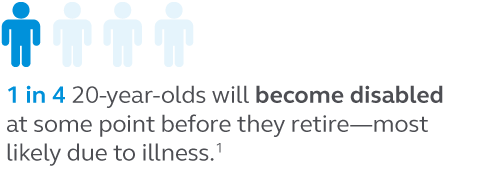It’s those middle-of-the-night worries. What if you get too sick or hurt to work? Or die unexpectedly? Could those who depend on you still pay the bills—and save for the future?
No one likes to think about those things. But life can change in an instant. People with a good financial plan hope for the best, but plan for the unexpected. Insurance helps with that.
- Disability insurance helps protect your income if you get sick or hurt and can’t work.
- Life insurance can help your family pay off debt and maintain their lifestyle if something happens to you. It can also help fund the kids’ college education or pay off a mortgage or funeral expenses.
These three questions are a good pressure check on how well you’re helping to protect your income and your family with insurance coverage.
1. Do you have disability and life insurance coverage at work? If yes, how much?
Contact Human Resources or your benefits administrator to get the details about any disability insurance and life insurance provided to you.
Questions to ask about disability insurance:
- Do I have short-term disability, long-term disability, or both?
- How much of my income would it replace?
- For how long?
- How long until I start receiving benefits if I’m disabled? (Called the “elimination period.”)
Usually, long-term disability coverage will replace about 60% of your paycheck. After taxes, though, that may only leave you with 40–50% of your income. It may not be enough, especially if you want to keep saving money for retirement. That’s why having another policy can help.

Questions to ask about life insurance:
- Do I have life insurance coverage?
- How much coverage do I have? (It may be a flat rate or based on your income.)
- Any special benefits attached to life insurance? Examples: business travel accident insurance, advanced payment when terminally ill.
- Is there life insurance that covers me after I retire from the company? (If so, this is usually a smaller amount.)
2. How much disability and life insurance do you need for you or your loved ones to maintain your lifestyle?
Say the disability policy you have through your job covers 40–50% of your paycheck. If something happens that puts you out of work for a while, and you aim to maintain your lifestyle, that work policy may not be enough for you.
The same goes for life insurance. If you doubt the coverage you have through your job would be enough to cover your final expenses, pay off debt, and provide for family members, then you may want to buy more life insurance to help close that gap.
If you want to beef up your coverage, you have 2 options.
Option 1: Buy insurance through work.
Disability and life insurance (also known as voluntary or supplemental coverage) are policies you buy through your employer, if they offer that option.
Advantages
- Premiums are often payroll-deducted, and generally lower than you’d pay on your own.
- Often you can get some level of insurance without medical underwriting (meaning, no medical exam or tests). You may be able to buy a higher level of coverage if you’re willing to go through a medical exam and lab work, though.
- You can take the life insurance coverage with you if you leave your job—you just start paying the premium directly to the insurance company.
Option 2: Buy insurance on your own.
This is an individual disability income or life insurance policy you purchase through a financial professional or online.
Advantages
- You can generally buy a larger amount of coverage, customized to what you need.
- You keep the insurance, even if you change jobs.
- You can increase your coverage as your income grows.

3. Will your life insurance go to the people you want it to go to?
These are also known as your “beneficiaries.” It’s who you choose to receive money from your life insurance policies when you die, such as a spouse, children, friend, business partner, charity, estate, or trust.
As life changes, your beneficiaries could also change. Divorced? Remarried? A birth or death in the family? All are life-changing events that may change who you want the money to go to. Check and update your beneficiaries as needed.
If you have life insurance through Principal, you can download the forms to choose or change your beneficiaries.
Next steps
- Need help figuring it all out? We’ll help you find a financial professional in your area.



